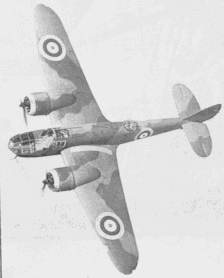It was one of the most commonly used light bomber of
the Royal Air Force (RAF) during the WW II. It was the military version
of a light twin-engined transport aircraft. This aircraft was, in Lord
Rothermere's intentions, the faster transport aircraft all around the world.
In fact, the Bristol Type 142 reached 495 km/h during test flights. It
was faster than all other fighters used by RAF, during that period. Unfortunately
the military version was not so successful in particular referring to defensive
armaments, 1 Browning gun-machine on wing mounting and 1 Vickers Type K
on a dorsal turret. The first flight was made on April, 12th 1935 and the
number of Blenheim's built during the war totaled 5500.
The Bristol Blenheim Mk I was an all metal, cantilevered
wing, twin engined with retractable landing gear. It was powered by two
Bristol Mercury VIII radial 9 engines, air cooled, 840 HP each.
Its first operational flight was on January 1937, but
showed a great inferiority toward German fighters and so it was used on
Mediterranean and African fronts.
The second production version, Mk IV, was powered by
2 Bristol Mercury XV radial 9 engines, air cooled, 920 HP each and it was
lengthened of 860 mm. The defensive armaments was greatly increased: 5
machine guns.
On September, 3rd 1939, one Bristol Blenheim Mk IV flew
the first operative reconnaissance mission of the war, within German airspace.
On August 1942 they were replaced by Douglas Boston and
de Havilland Mosquito. Engine: 2 Bristol Mercury VIII 618 KW each, Wing
span: 17.17 m, Length: 12.12 m, Wing surface: 85 sqm, Take off weight:
55.62 KN, Max. speed: 428 km/h (3600 m), Operative ceiling: 8315 m, Range:
1810 km. |

